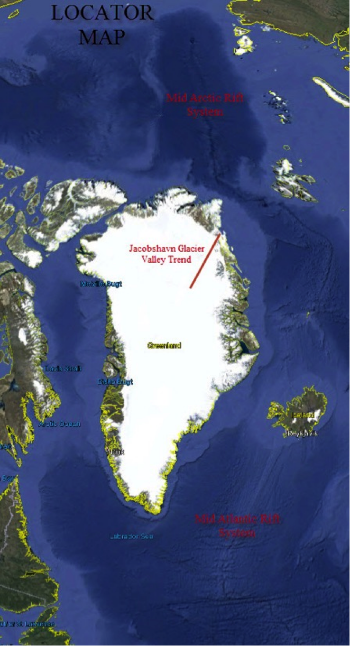Written by James E. Kamis on 29December2014
Newly released research, primarily from NASA and the GFZ German Research Center for Geosciences, indicates that melting of selective Greenland Glaciers is related to geologically induced heat flow, and not manmade atmospheric global warming.
Previous articles posted here and here have documented the effect of geologically induced geothermal heat flow on the West Antarctic continent and Arctic Ocean Ice Sheets. In both cases relatively recent research was used to show natural variations in climate, climate-related events, and warmed from geothermal heat. You can learn more about plate climatology and global warming here.
A summary of the very extensive NASA Greenland Ice Sheet Study shows that Greenland Glacier dynamics are very complex. Certain glaciers are retreating, others are unchanged, and still others are expanding. Additionally, individual glacier dynamics change with time, e.g., advancing for years, then suddenly retreating. In some cases the retreating rates are astounding.
NASA also noted that glaciers melt from both beneath (bottom melting) and on top (surface melting). Extensive bottom melting is thought to be lubricating several glaciers and thereby greatly increasing surface velocity rate. In other words, they flow much quicker, and in many cases, extremely fast.
Locator Map
The area of greatest and most recent glacier retreat is located in the northeastern portion of Greenland and is associated with a very linear NNE trending bedrock valley termed the Jacobshavn Glacial Valley (see locator map above).
A newly published bedrock topography map of Greenland (see below) shows the prominent Jacobshavn valley topographic low. This valley extends miles into the Greenland continent and is shown as a fault-controlled valley due in large part to its very narrow and linear geometry. Additionally the NNE trend of this valley mimics the NNE trend of known Greenland fault trends such as those shown in the Nuuk Region.
The north eastern quadrant of Greenland, and most importantly the Jacobshavn Valley, is in close proximity to the southern terminus of the Mid Arctic Rift System (see Locator Map). Other scientists have taken this as strong evidence that this part of Greenland is faulted and more tectonically active than most other portions of Greenland. Recent seismic activity in this region supports this notion.
The movement of the Jacobshavn Glacier in the Jacobshavn Valley is of great interest. NASA’s Study shows that this glacier was flowing very slowly down the valley and at the same time started gaining ice mass until 1998. At that point, it quickly started flowing down the valley while simultaneously losing large amounts of ice mass.
This rapid change in Jacobshavn Glacier flow rate is illustrated on the NASA map above as a unique and a very linear trend that fits the topographic expression of the Jacobshavn Valley.
It is clear that the Jacobshavn Valley is geologically fault bounded, and has recently become geothermally active. All the data and observations fit this notion, so a sudden increase in fault-related heat flow would cause bottom melting of the glacier.
In addition to bottom shrinking of the glacier and thereby down-faulting (sliding) into the valley, this bottom melting also generates a basal layer of liquid water that acts as a lubricant to speed up the glacial flow.
Also of significant relevance to the geologically induced geothermal heat flow of Greenland is a recently published research project by the GFZ German Research Center for Geosciences.
“At the Earth’s surface, heat fluxes from the interior are generally insignificant compared with those from the Sun and atmosphere, except in areas permanently blanketed by ice. Modelling studies show that geothermal heat flux influences the internal thermal structure of ice sheets and the distribution of basal melt water, and it should be taken into account in planning deep ice drilling campaigns and climate reconstructions. Here we use a coupled ice–lithosphere model driven by climate and show that the oldest and thickest part of the Greenland Ice Sheet is strongly influenced by heat flow from the deep Earth. We find that the geothermal heat flux in central Greenland increases from west to east due to thinning of the lithosphere, which is only about 25–66% as thick as is typical for terrains of early Proterozoic age. Complex interactions between geothermal heat flow and glaciation-induced thermal perturbations in the upper crust over glacial cycles lead to strong regional variations in basal ice conditions, with areas of rapid basal melting adjoining areas of extremely cold basal ice. Our findings demonstrate the role that the structure of the solid Earth plays in the dynamics of surface processes.”
The recent discovery of two Sub-Glacial Freshwater Lakes beneath the Greenland Continental Ice Sheet is highly significant.
Although not interpreted as being related to geothermal heat by the authors, it is clear that geothermal heat is the most likely cause. The two lakes are located in the north central portion of Greenland beneath 1500 feet of ice and 30 miles from the ice-free edge. They each cover an area of five square miles, and most importantly, are oriented in the NNE linear trend, a fault-riddled area.
The evidence for geologically induced geothermal heat flow on the Greenland continent shows that recent reports from NASA on Greenland ice melt from global warming are premature and ill informed based on the following observations;
- Glaciers do not melt uniformly as would be expected from atmospheric global warming, rather the melting and advancing of the glacial is complex and therefore more likely associated with geological forces.
- The most significant and most recent glacial melting occurs in what is likely a geologically faulted linear valley that is theorized to have increased heat flow.
- Sub-glacial freshwater lakes have been identified.
- Newly released research by other scientists agree that geothermal forces are active in Greenland
The argument favoring a geological origin to Greenland glacier ice melting is heating up, specifically geothermally.






